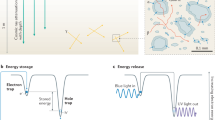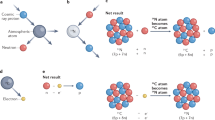Abstract
Natural radioactivity can produce measurable amounts of radiation damage in rocks and glasses, and the gradual accumulation of this damage with time provides a built in ‘clock’ that can be used as a dating tool for geology and archaeology. Although a studied technique for estimating this damage involves measurements of stored thermoluminescent (TL) activity1–4, several authors have reported the direct observation of natural radiation damage by ESR5–7. We describe here ESR measurements on a damage signal which we have found to be present without exception in a wide variety of natural flints. The point defect responsible for the signal is identified and the samples are calibrated with an artificial damage simulation. Preliminary age determinations are presented for several natural flints. Flint artefacts heated in antiquity will have their clock ‘reset’ to zero, and measurements on one sample suggest that the ESR technique may have applications in the study of early cultures.
This is a preview of subscription content, access via your institution
Access options
Subscribe to this journal
Receive 51 print issues and online access
$199.00 per year
only $3.90 per issue
Buy this article
- Purchase on Springer Link
- Instant access to full article PDF
Prices may be subject to local taxes which are calculated during checkout
Similar content being viewed by others
References
Aitken, M. J. Physics in Archaeology 2nd edn (Clarendon, Oxford, 1974).
Fleming, S. Thermoluminescence Techniques in Archaeology (Oxford University Press, 1979).
Hackens, T., Aitken, M. J. & Mejdahl, V. (eds) Pact Vol. 3 (Council of Europe, 1979).
Wintle, A. G. & Huntley, D. J. Nature 279, 710 (1979).
McMorris, E. W. Nature 226, 146 (1970).
Ikeya, M. Nature 255, 48 (1975); Archaeometry 20, 149 (1978); Science 207, 977 (1980).
Robins, G. V., Seeley, N. J., McNeil, D. A. C. & Symons, M. R. C. Nature 276, 703 (1978).
Weeks, R. A. J. appl. Phys. 27, 1376 (1965).
Griscom, D. L. J. non-crystalline Solids 31, 241 (1978).
Friebele, E. J. & Griscom, D. L. Treatise Mater. Sci. Technol. 17, 257 (1979).
Friebele, E. J., Griscom, D. L., Stapelbroek, M. & Weeks, R. A. Phys. Rev. Lett. 42, 1346 (1979).
Thompson, M. W. Defects and Radiation Damage in Metals 125 (Cambridge University Press, 1969).
Kinchin, G. H. & Pease, R. S. Rep. Prog. Phys. 18, 1 (1955).
Thompson, M. W. Defects and Radiation Damage in Metals 151, 157 (Cambridge University Press, 1969).
Bordes, R. A Tale of Two Caves (Harper & Row, New York, 1972).
Author information
Authors and Affiliations
Rights and permissions
About this article
Cite this article
Garrison, E., Rowlett, R., Cowan, D. et al. ESR dating of ancient flints. Nature 290, 44–45 (1981). https://doi.org/10.1038/290044a0
Received:
Accepted:
Published:
Issue Date:
DOI: https://doi.org/10.1038/290044a0
This article is cited by
-
Radiation-induced defects in quartz. IV. Thermal properties and implications
Physics and Chemistry of Minerals (2009)
-
Radiation-induced defects in quartz. III. Single-crystal EPR, ENDOR and ESEEM study of a peroxy radical
Physics and Chemistry of Minerals (2009)
-
Radiation-induced defects in quartz. II. Single-crystal W-band EPR study of a natural citrine quartz
Physics and Chemistry of Minerals (2008)
-
Radiation-damage-induced defects in quartz. I. Single-crystal W-band EPR study of hole centers in an electron-irradiated quartz
Physics and Chemistry of Minerals (2008)
-
ESR study of thermal history and dating of a stone tool
Applied Magnetic Resonance (1997)
Comments
By submitting a comment you agree to abide by our Terms and Community Guidelines. If you find something abusive or that does not comply with our terms or guidelines please flag it as inappropriate.



